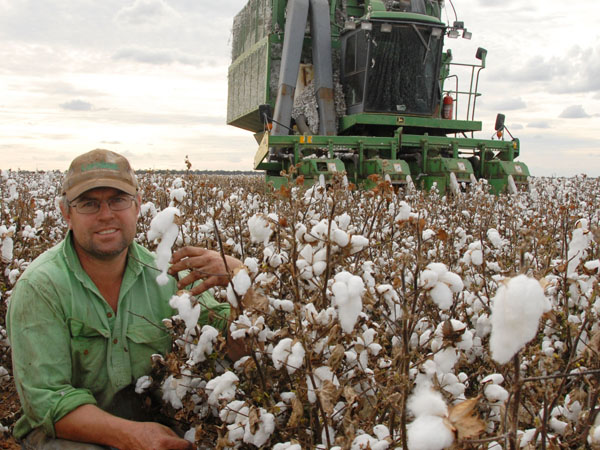The economic and environmental rewards for cotton growers
By The Cotton Research and Development Corporation and CottonInfo
The installation of a solar diesel hybrid irrigation bore pump on a cotton farm in Central West New South Wales has led to cuts in fuel costs, greater irrigation efficiencies, and a massive reduction in greenhouse gas emissions.
Attracted by the drop in the price of solar panels in recent years and the prospect of the system paying for itself in less than four years, Andrew Gill and his family decided to install a solar diesel hybrid system at one of the pump sites on their Narromine farm.
The move has led to a cut in pumping costs from $76/megalitre to $41/ML and slashed diesel use by between 45,000 and 55,000 litres a year. Over 25 years, that equates to a saving of more than 1 million litres of fuel and a reduction of over 3000 tonnes in carbon emissions.

Cotton farmer Andrew Gill on his property. Photo: Clare Gill.
Jon Welsh, a technical specialist with the cotton industry’s extension program, CottonInfo, and Janine Powell, a cotton research economist, worked through project economics costings and carbon emissions profiling with the Gill family during feasibility.
“If potential productivity gains and environmental benefits exist, we need to share this technology and information with the wider cotton industry,” said Jon.
Andrew said that while the environmental achievements were important, the clincher was the economic viability of the project which promised a quick return on investment.
“Diesel prices are the lowest they have been in 12 to 13 years, but it’s not going to be cheap for the next 20 years, it’s only going to go one way, and that’s up,” he said.
“Solar is a way for us to have a better handle on what our input costs are going to be throughout the next 20 years of production. It is not often you can get that.
The Gills run sheep and cattle, and grow summer and winter dryland and irrigation crops, including 300 hectares of cotton each year.
“For people who can use solar energy every day, it’s just mad not to do it,” Andrew said.
They have no access to river water, only bore water. Their irrigation pumping system has traditionally been run exclusively by diesel pumps.
“For the past few years we have been trying to get better fuel efficiency out of our diesel turbine pumps,” Andrew explained.
“We found our turbines were at their highest efficiency point already. We couldn’t really achieve much more efficiency, so we looked at cheaper ways to get the water out of the ground.”
The Gill’s decided to install the solar diesel hybrid system at one of their bore sites that provides year-round pumping into a large irrigation reservoir.
The new installation consists of 400 solar panels on four banks, producing 100 kilowatts of power to run a submersible pump. Being a hybrid system, the pump is run on solar energy when there is sufficient irradiance from the sun, then switches to a diesel generator when the irradiance falls away.
Andrew said he was continuing to look into ways to fine tune the system and improve its efficiency. Convinced that solar is the way of the future, he plans to introduce more solar pump stations throughout the farm.
For more information, visit www.cottoninfo.com.au/energy-use-efficiency.



